|
|
|
I have a no-start situation with my '92 945t. It wouldn't start last Friday after my wife parked it at the curb in front of the house. After getting it pushed into the garage and running some quick diagnostics, I replaced the fuel pump because the existing one didn't sound good and showed high current draw (about 12A for both pumps). I also didn't seem to have fuel pressure at the rail.
The replacement pump is a Carter, and seems fine except for the lack of a check valve. There is fuel at the rail, as evidenced by using a tire pressure stick gauge on the Schrader valve between #1 and #2 intake. I get the prescribed liter of fuel in 30 sec of cranking from the FPR return. This works both with the fuel system relay in place, or with a jumper from 30 to 87-2 to force the pumps to run. I can hear the in-tank pump running, the in-tank is new and both pumps together draw about 9A. I think the fuel side is probably OK, although I don't have a proper gauge set.
I have spark-- I pulled the #1 wire, put a plug on it and grounded it on the intake and cranked the car-- I see good spark.
I checked the OBD system, and get 1-1-1 on sockets 2&6.
I had a bunch of radio suppression relays and 2 used power stages that I have swapped in. Still no start.
The cap and rotor were new late last summer, the RPM sensor was replaced last spring, the timing belt has about 8K km on it.
Any suggestions about what to try next? I need this car on the road again!
Thanks in advance!
--
Herb Goltz, Aurora, Ontario, Canada '92 945t 210K mi
|
|
-
posted by
someone claiming to be rjk
on
Sun Feb 17 01:19 CST 2008 [ RELATED]
|
|
Have you looked at the MAF?
WIth the key off, disconnect the MAF. Try to start it.
Second possibility is a slipped timing belt.
What color is the spark you have observed? Yellow is weak, blue is good.
I had one where the spark was weak, it would jump a gap in normal atmosphere but not under compression.
|
|
-
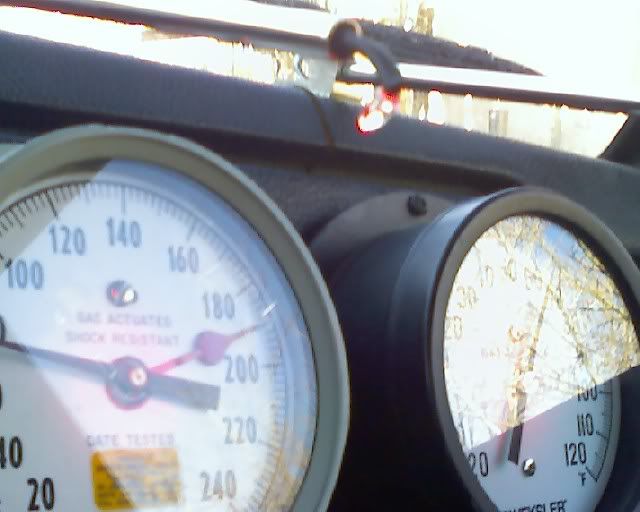
|
|
Hello Herb,
Check this out:
http://www.threefattigers.com/Protocore/Volvo/TimingMarks.htm
You gave it a good enough shot of starting fluid, something else is wrong. I feel that a compression test may be in order, but if you don't have the gauge, you might just check all the sprockets to make sure that they are moving and in time.
You said that the plugs were dry, and that the injectors were operating. This means that there is a lack of fuel, but now with no start after fluid, there seems to be another problem.
I really think it is time to use gauges. You should try to splice in a gauge port into place along the fuel supply hose to the rail. I have a spare gauge to sell you, but you'll need fittings too. On my end, I am unfamiliar with the 900 series and so I don't know where you should splice the line into or what fittings to buy.
Here is a picture of the gauge work I've done on my 200, and after, the pictures of spare gauges:
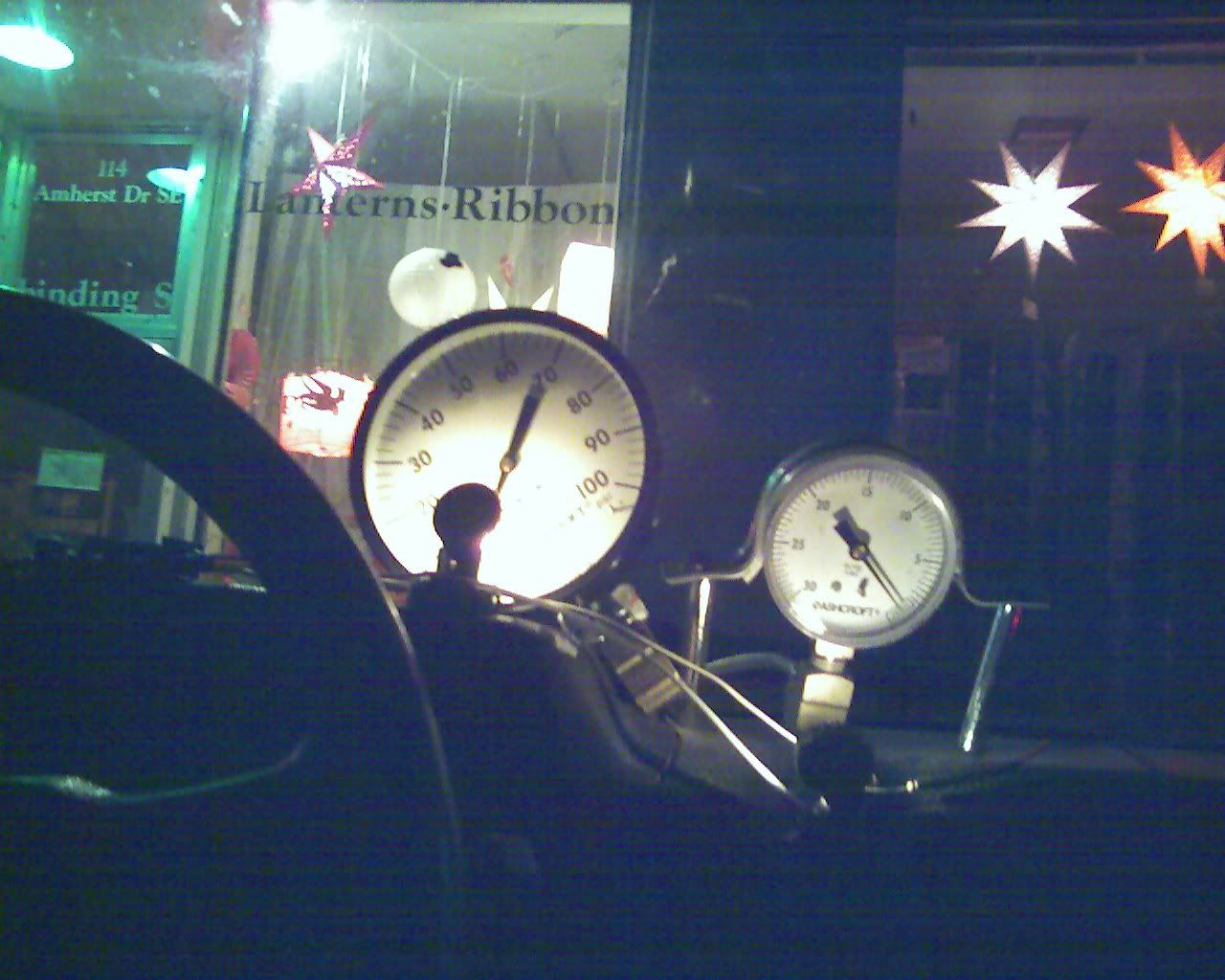
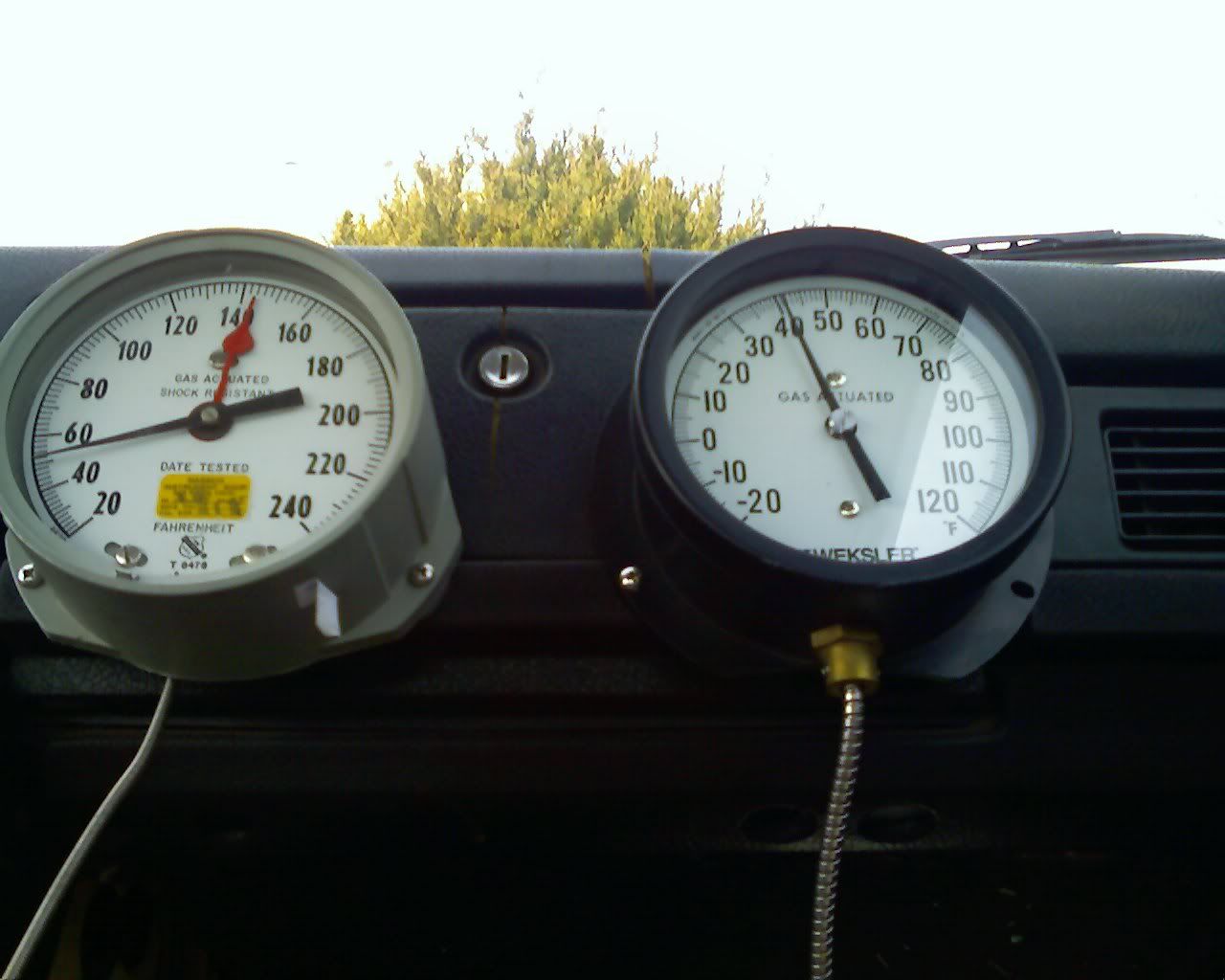
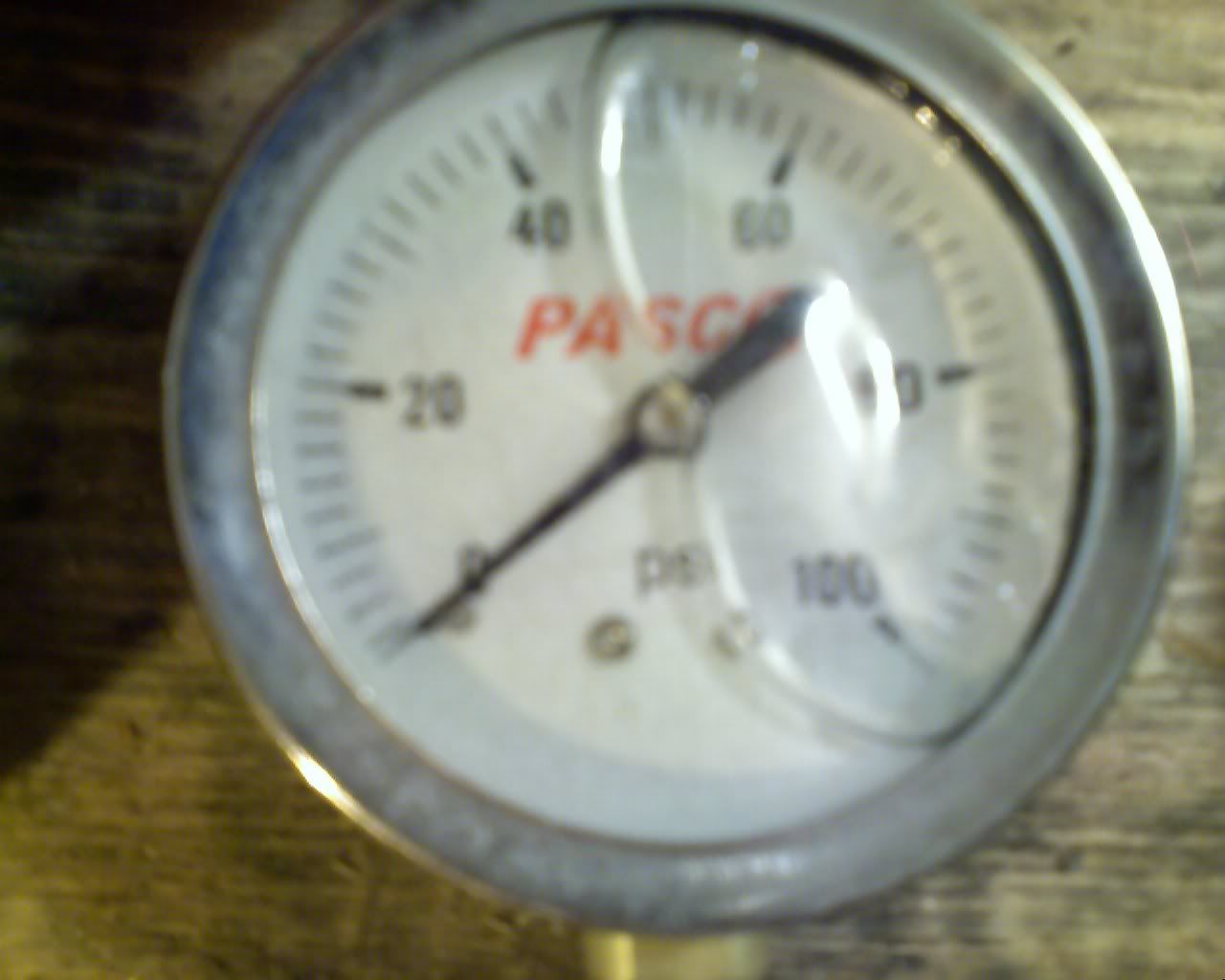
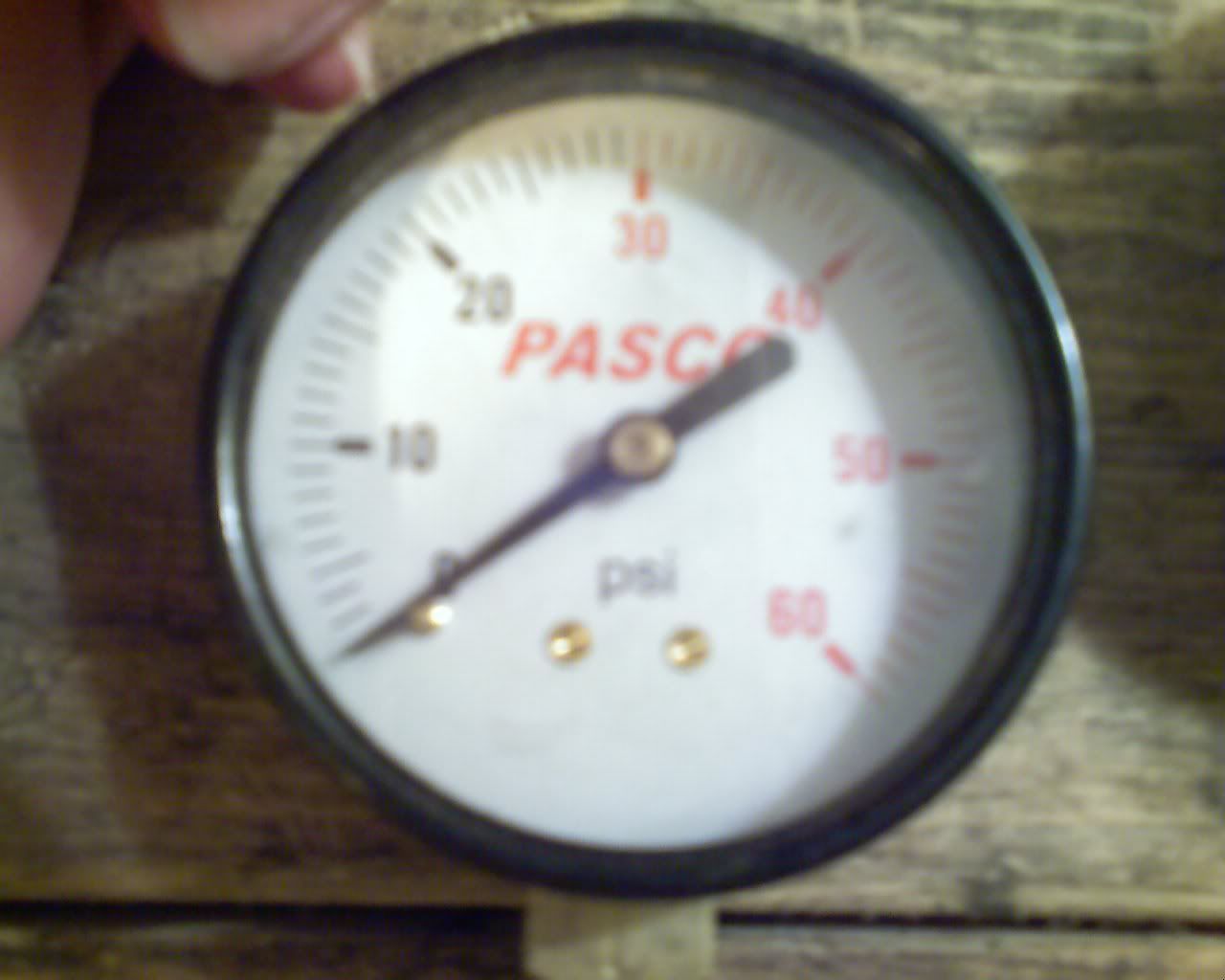
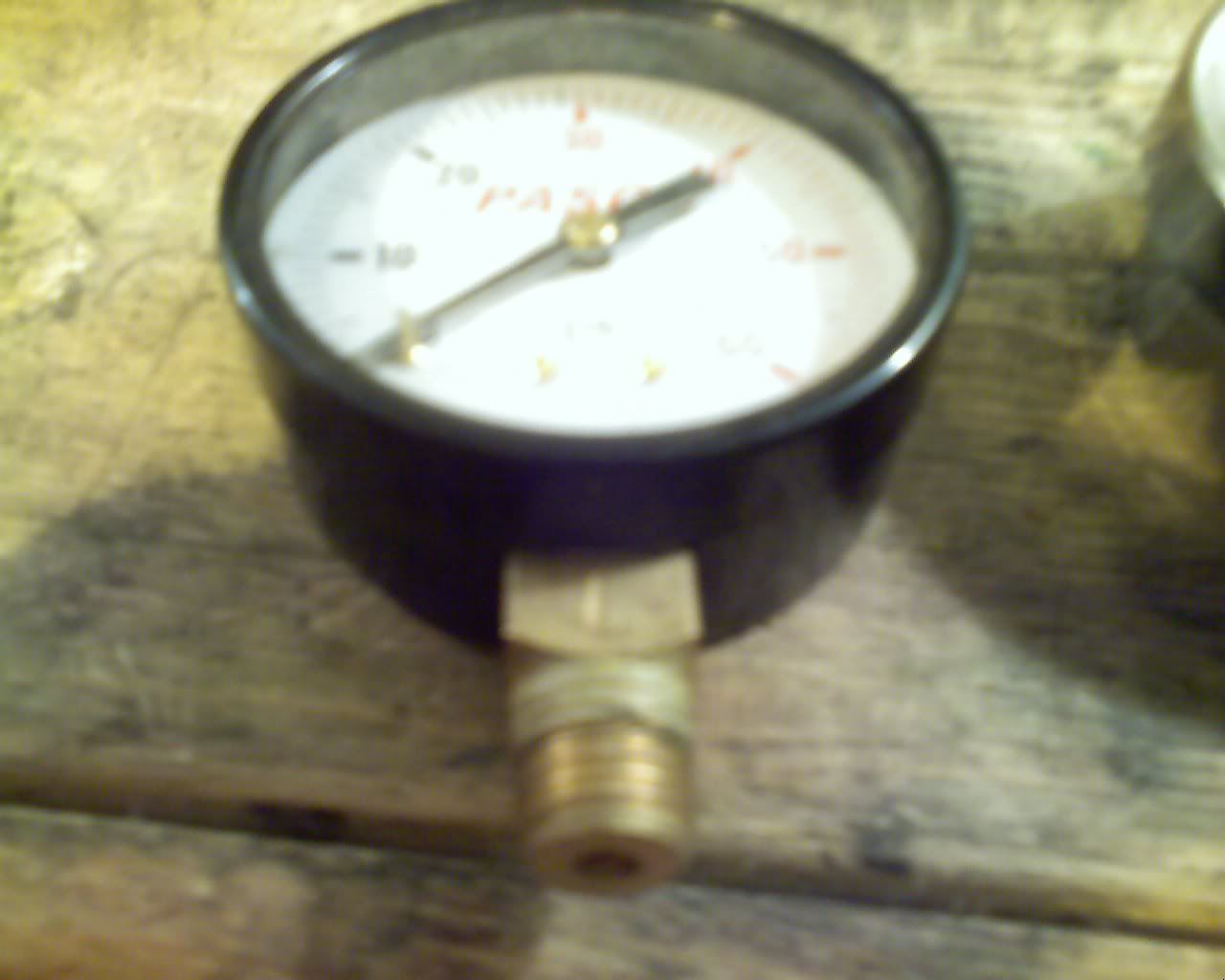
|
|
-

|
|
After reading your posts, I did not see anything that ruled out the problem I had. My 1993 had a no start issue that had me stumped for weeks. At least it died in the driveway. I had fuel and spark. Fuel pressure tested ok. OBD checked ok. The issue ended up being a sheared camshaft pulley indexing roll pin. The cam pulley appeared to be turning normally but it was found about 180 deg off. The engine rotation should have been noticeably faster due to no compression but it wasn’t. Simple check, put the engine at TDC and check number one cam lobes via the oil filler cap. Both intake and exhaust lobes should be up.
Tom
|
|
-
|
|
|
Hello Tom:
That is an interesting suggestion-- I have to admit I have never had to find TDC on a cam driven distributor B230 (in fact, I have never had to touch a cam on one of these cars)-- can you talk me through how you put it at TDC with the rear-mounted distributor? I'm assuming you pulled the cap and rotated the motor until it pointed to the #1 wire and then went from the timing marks on the timing cover for the fine alignment...
Also, is the index pin you are referring to at the front of the engine? I had a look in my admittedly crummy Haynes for the 240 I used to have, and I couldn't find any diagrams showing it. I looked up some of your posts on this subject, but the pictures aren't with the posts anymore.
This sounds promising-- I'd like to check it out today.
Any other suggestions would be welcome-- I am running out of ideas and I haven't had a running car for two weeks now!
The timing belt was done by the local indy last year this time-- I suppose if the sprocket wasn't tightened properly, this could be the eventual outcome.
Thanks for the post-- I think it is time for me to establish a new thread with what I know and don't know about this beast...
--
Herb Goltz, Aurora, Ontario, Canada '92 945t 210K mi
|
|
-
|
|
|
You have spark, fuel pressure, and oxygen - the three required ingredients to make it run. One possibility is that the injectors aren't opening. With the key on, you should be able to read 12v constant at the injectors (which would verify a good RSR). The CPU then completes the injector circuit to ground as needed to open the injector for the prescribed duration - short duration when idling or decelerating / longer duration when putting the pedal to the metal. Short of actually pulling the injectors out of the engine to see if they're spraying, someone else may know of a simple way to check that the computer is completing the injector circuit to ground.
Are the spark plugs wet or dry? If dry, I'd suspect something like the above. If wet, I'd suspect it's getting TOO MUCH fuel and flooding, like maybe the FPR has gone bad or the fuel return line is obstructed. But if it runs perfectly fine one minute, then won't run at all the next minute, I'd lean toward the "not getting ENOUGH fuel" theory.
Good luck.
|
|
-
|
|
|
Are the injectors actually pulsing and delivering fuel to the cylinders? Are the plugs wet after repeated attempts to start the car?
If you have fuel and air being delivered to the cylinders and spark at the correct time perhaps you have lost compression.
I purchased a car last summer with a no start situation that turned out to be no compression because repeated efforts to start the car washed the cylinder walls down and sufficient compression was lost to fire the cylinders. They had thrown a ton of parts at it with no results.
If the plugs are wet try squirting a couple of tablespoons of motor oil into each cylinder. Disconnect the injectors and spin the engine for 15 seconds or so, you might even repeat this process. Reconnect your injectors and try again.
If you are not getting fuel out of the injectors and you have pressure at the rail it sounds like the injectors are not pulsing. Have you simply jumpered the radio suppression relay socket? Put a jumper between the two heavier wires. That will cause the injectors to pulse when cranking and in a relatively quiet environment you should be able to hear them click when the engine is cranked over.
If the jumper doesn't allow the injectors to pulse I would turn my attention to running some tests on the ECU.
Randy
|
|
-
|
|
|
Hello Randy:
I had my wife crank the car with a long screwdriver an injector body and the other end to my ear-- I could hear some of the familiar clicking, so I am assuming the injectors are opening and closing.
I tried jumpering across the two heavy wires-- it didn't start that way either.
I'm not convinced my jumper job was perfect (I just stripped a wire on both ends, balled them up and stuffed them in the socket), but I couldn't see voltage at the injector.I tried key position two with all 3 radio suppression relays in my parts stash and didn't see voltage on the injector.
Do you know if a -561 white label would work with a turbo? I do have an ECU that I could try...
I haven't tried the oil in the cylinders yet-- I have the car in a very tight spot in the garage and can't get access right now-- we're in the midst of what looks like a storm that will bring a foot of snow.
Riding the bus is getting old-- I need this car running!
Thanks for the ideas!
--
Herb Goltz, Aurora, Ontario, Canada '92 945t 210K mi
|
|
-
|
|
|
The white label 561 is for LH 2.4 NA cars. I don't know what the 92 turbo uses but personally I would not swap it out for a 561
I am sure the jumper was just fine as you heard the injectors clicking and most likely your Radio Suppression Relays are good to if you can hear the clicking.
Randy
|
|
-
|
|
|
Hi Randy:
I could feel the relay energizing in my hand, and I am sure I was hearing the injector click-clacking. I am hoping you are right about the RSR being OK. I couldn't see any voltage at the the injector harness with the key in position II, either with the relay in place or a jumper to take the relay out of the circuit.
I won't try the -561 until I know which ECU is in there, as well as compatibility with others.
I am hoping I can try the oil trick tonight. Any further suggestions?
Thanks for the posts!
--
Herb Goltz, Aurora, Ontario, Canada '92 945t 210K mi
|
|
-
|
|
|
The oil is something I would add if you feel you are actually getting fuel in the cylinders.
Are the plugs wet with fuel when you pull one after attempting to start the car? If so the oil is a way of covering the possibility of too much fuel washing down the cylinder walls.
If there is no evidence of fuel in the cylinders I would give it a good shot of starting fluid. It is not easy to do in these cars but it is doable.
A single pop on starting fluid would point at a fuel delivery problem as you have indicated you have spark.
Randy
|
|
-
|
|
|
Thanks Randy:
I just tried a few things-- I pulled the plugs, only one looked remotely wet, maybe a little oily. The three I could get to in the bad lighting were a little fouled looking.
I also tried jumpering out the fuel system relay again, this time making a y-jumper as suggested by lucid, from #30 to #87-1 and #87-2. No change.
I oiled the cylinders when I had the plugs out-- no change.
I have a working theory now that I may need a new ECU. From the FAQ:
Common symptoms of a failing LH injection module:
* Engine will not run at idle
* Air-fuel mixture is too rich (this can damage catalytic converters)
* No fuel pump operation, butthefuel pump operates when its relay is jumpered between pins 30 and 87/2
* The engine will not rev higher than 3000 RPM
* Engine will not start, spark plugs are dry and the ignition system produces spark.
* Multiple error codes, sometimes randomly generated, despite using known good sensors and components.
To me, it looks like: Engine will not start, plugs are dry and the ignition system produces spark. I can run the pumps with pins 30 and 87-2 jumpered.
I get no error codes on the OBD. Another set of coincidences that I have just realized-- I blew one headlight low beam last week and now the other one has blown too. I wonder about a spike in voltage causing the ECU to bite the dust...
Do you have any idea how to do a diagnostic work-around on the ECU? If I can confirm it, I may be able to pull one at a pick-and-pull on the weekend...
Thanks again!
--
Herb Goltz, Aurora, Ontario, Canada '92 945t 210K mi
|
|
-

|
|
What is the battery voltage?
I wouldn't worry about blowing your engine with starting fluid, a turbo has lower compression then a regular gasoline engine. Also I KNOW that an engine will run on straight propane. If your spark is good, then there is no reason chasing a goose. MAKE SURE THE ENGINE IS SOUND before investing in any parts. The engine will either run with fuel and spark or it won't, and if it won't run with fuel and spark, no computer on earth will fix it.
I shall leave the logic up to you. From my perspective, the computer could be at fault just as much as the engine could have mechanical issues. Equal chances for me to choose from. 50/50, a coin toss. I have the luxury of blind choice as I'm about 2000 miles away here in New Mexico.
I shall reiterate further, There are two choices, an electrical problem or a mechanical problem. Those are the only two choices available, and both at once is very unlikely. One must determine where the demon lies or the punishment is a commuter bus transfer slip.
Why are the plugs dry? This is the question. The injectors were clicking, right? The computer must be active. What then could be the problem? If the injectors were opening as inferred from the audible click, then why is no fuel being sprayed?
Lets review. You said that the change of the regulator repaired the fuel system. You put a old one on and Voila! gas came out the return line, and it didn't do that before. That must have fixed it.
Well that's not the only thing that you did in the interim while the battery charged. You added a gallon of gas for insurance as I recall. AFTER the battery charged, AFTER you changed the regulator, and AFTER you added fuel then you tried the liter/30 sec test. Right or wrong?
There is a gaping fracture in this logic, the logic that the regulator must have repaired the fuel system. Imagine that the regulator were to be removed and the end of the rail plugged. Instead of being ~35 psi pressure, the pump would produce full pressure ~70 psi. The pump has an internal bypass to limit pressure to that figure, as noted by the factory. I myself had a plugged regulator, and the engine ran great, too good. The mixture was rich, but it still ran. I saw the gauge and it read ~70psi, I heard the pump, it was bypassing, I saw the regulator and it was plugged.
You're probably saying that I'm off on a ledge. Even if I was a space dog with three sets of genitals, the fact remains that the regulator could not have been the cause of the problem, I've proved it with deduction and reason.
Well I have to get back to solving radical equations before I get demonized, but by numbers and letters instead of German fuel systems. I better watch out for aliens too, Roswell, NM is just hop and skip away!!!
|
|
-
|
|
|
Hello:
The battery voltage was over 12V, but varied with how much cranking was going on.
I take your point about the engine needing to be sound-- I have no good grounds to assume it isn't mechanically sound-- no noises, no change in oil consumption, no evidence of oil in the coolant. Before the car stopped starting, it was started normally, backed out of the driveway and parked across the street. All low rpm stuff-- no drama.
The injectors could be heard when cranking. I never got a measurement of 12V across the injector harness terminals with the RSR jumpered out (fat wire to fat wire). This is an inconsistency I need to explore. Pulling the injectors out and cranking would be the clearest way to demonstrate the presence or absence of fuel, but that isn't appropriate in the garage (part of the house!). Perhaps if it warms up I can roll it out and try it.
To be clear, I don't think the FPR fixed my _original_ fuel problem-- I had swapped for a used one at the beginning of this process because a failed one is a common cause of no-starts. The one I put on was clearly defective. Swapping it out resulted in good flow, but only _after_ the replacement of the pump and filter.
To make matters worse, I also swapped RSRs and power stages too.
I may be able to pick up a cheap ECU on the weekend.
Thanks for your posts!
--
Herb Goltz, Aurora, Ontario, Canada '92 945t 210K mi
|
|
-

|
|
"The injectors could be heard when cranking. I never got a measurement of 12V across the injector harness terminals with the RSR jumpered out..."
I don't think you will see "12V across the injector harness terminals", because the "ground" terminal is grounded (by the ECU) for such a short time. But since you can hear them, I guess we can assume the ??V is there. Coming thru the ballast resistors it will be much lower than 12V. I'm guessing 4V or so, but really don't know.
Whatever the voltage is, you should see it (with Key on II) at the rightmost harness plug socket, when facing it with the latch spring at the top.
In any case. the ECU is not directly involved with injector voltage, except for energizing the Fuel relay. From there on it's relay points, wires, and the ballast pack.
The mystery is why the plugs aren't wet if you've got Fuel Pressure and Clicking Injectors?
It still sounds like a fuel problem, since you said you had a good spark when grounding a plug.
--
Bruce Young
'93 940-NA (current), 240s (one V8), 140s, 122s, since '63.
|
|
-
|
|
|
Thanks Bruce:
Your fuel system suspicion is interesting... If the system has two pumps that are running, a new fuel pump and filter, has fuel at the rail and bypassing out the FPR both with the fuel system relay in place and jumpered out, there is spark, and there appears to be some injector activity as well as what appears to be a good RSR, what do you think of the probability of the no start being due to a fried ECU?
The sudden no-start, with dry plugs and a fuel system that runs when forced and the presence of spark is a set of symptoms from the FAQ describing ECU failure.
I wonder what tests would point to the ECU definitively...
Any further thoughts?
Thanks again!
--
Herb Goltz, Aurora, Ontario, Canada '92 945t 210K mi
|
|
-

|
|
Recall my friend, when I spoke of the coin toss. Did this not strike you as right? Did not suspicion extend to every part of the car, from the front to the back? Admit now your current suspicion, the one of the electronic computer. Does it not seem that out of order? I mean to say that it seems "in order" and not "out of order".
That must be correct, as it cannot be in and out of order at the same time. Still, you said yourself, there seems to be activity at the injectors, so it must be in order. Remember friend, you also said there are dry plugs, and so could be out of order.
How is this? Why is there no start? What is the real problem?
The answer must not be in the action, but the inaction. I mean to say that the problem is not that there is activity, but the problem is that there is no activity. Follow this, a man is not healthy when sick, or sick when healthy. he is sick when he is sick.
The problem must then lie in "there are dry plugs", and obviously so, because it is not broken because the injectors are active.
The question is "why are the plugs dry?" This is the problem that must be addressed. Further, the problem cannot be the computer because the computers job is to click the injectors. If the injectors are clicking now, then they will continue to click with any good computer. The injectors will not stop clicking if a new computer is installed. It follows then that If the injectors are clicking, then the computer is good.
We must dig further then. I ask why the plugs would be dry when the injectors are active. The answer must be that the fuel is not being properly injected, and by no fault of the computer, as it was established that the computer is active. The fault cannot lie in the injectors because all of the injectors would not fail at once, The problem must lie in the fuel itself, for it is said by the statement "The plugs are dry" that the engine does not run because there is no fuel.
I submit to you sir that there must be no fuel to the injectors. Or at least, that fuel is not being supplied to the injectors properly. Now consider that the only part that has not been inspected or replaced besides the lines is the tank pump assembly. You made a surface inspection as you said it was rusty I recall, but the inspection ended at the observation that there was no exterior leak, right?
It follows then that the next step is to accurately gauge the fuel pressure, or remove the tank pump assembly for inspection. I do not forget sir that it was stated as replaced "about a year ago", but this does not exempt it from inspection any more then it exempts the regulator from replacement.
I have in my possession a fuel pressure tester I purchased from Autozone for the sum of about $35. Included was the attachment for schrader valves.
I hope you follow me, as the answer is clear to me. This clarity ought to be revealed to you as well.
Goatman
|
|
-
|
|
|
If there's a schrader valve on the injector rail, how about just sampling it with a tire pressure guage - crude but effective to see if you are at least in the ballpark.
|
|
-
|
|
|
Hi Chris:
I did this-- I didn't get an accurate reading, but it did spray all over (I haven't done it since-- the car is in a very tight spot in my overfull garage). There was a significant amount of fuel pressure when I swapped out the FPR too, as well as fuel bypassing from the FPR at the green book-prescribed rate with the fuel system relay in place and bypassed.
Any further thoughts on this? I am hoping to get to a boneyard tomorrow AM-- I can get an ECU for about half of what it will cost to tow to the local Volvo indy, so I suppose it is worth a shot...
Thanks!
--
Herb Goltz, Aurora, Ontario, Canada '92 945t 210K mi
|
|
-

|
|
Herb,
In yesterday's posting you said, "...and there appears to be some injector activity...". I believe that was based on your hearing "clicking", which I'm not comfortable with. I believe that with good fuel delivery, pressure at the rail, and spark, you should actually see evidence of fuel on the plugs after a few seconds of cranking. If not, about all that's left is the resistor pack, injectors, or ECU—and I'm not certain about what you heard clicking.
Before spending anything on an ECU, I'd suggest buying an Injector Test light like this one at IPD aka a "'noid light". You can get them at most any parts place, and for less than $10 it will confirm whether the ECU is grounding the injectors or not.
NOTE: It's testing both voltage and grounding. Not just voltage as IPD's blurb implies.
--
Bruce Young
'93 940-NA (current), 240s (one V8), 140s, 122s, since '63.
|
|
-
|
|
|
Great advice as always!
I found a local Volvo mechanic (20 years dealership experience). After describing the symptoms and the current fuel system status, he felt strongly that it was the injectors, and was leaning heavily toward a diagnosis of a cooked ECU.
His feeling was that the fuel side was fine (he said 90% of the time if you got a spray rather than a dribble from the Schrader valve on the rail you would be in good shape).
He has a 'noid light, a known good -563 ECU, a known good RSR, and will lend me the tool and sell me the parts for a reasonable price-- less than the price of a tow to the local Volvo indy.
I am supposed to meet him on the other side of town tomorrow to pick up the parts and the 'noid.
Hopefully this will be the end of this adventure-- I will post what happened tomorrow. It would be great to sort this out then...
Thanks again!
--
Herb Goltz, Aurora, Ontario, Canada '92 945t 210K mi
|
|
-
|
|
|
"...I never got a measurement of 12V across the injector harness terminals with the RSR jumpered out..."
When I said to check for voltage at the injectors, I didn't mean probing across the two contacts on the injector. I meant to put the (+) probe on either one of the injector contacts, and the (-) probe on chassis ground. The whole purpose of that was to simply verify that the RSR was passing voltage to the injectors.
|
|
-
|
|
|
Do you have any idea how to do a diagnostic work-around on the ECU?
I have used the information in Bentleys to do the various pin out tests on ECU in the LH 2.2 systems.
It never hurts to have a spare ECU on the shelf assuming you do not have to invest a lot of money in it.
|
|
-

|
|
Hello Herb, I'm troubled by your lack of response to my previous threads. I'm just trying to help you, even though my humor seems at times cryptic.
Again, as stated, the car may not be getting enough fuel, try the starting fluid in the hose port on the manifold. Also try the oil in the cylinders.
Awaiting your response,
Goatman
|
|
-
|
|
|
I tried the starting fluid (actually more than once), but in small doses-- I once wrecked a slant-6 motor in my father's pick-up truck with too much starting fluid... With the current problem it didn't start with the fluid.
I haven't tried the oil in the cylinders yet-- the car is shoe-horned in a full garage and we are in the midst of a major snowstorm. If I can wiggle my way in there tonight I will try the oil.
Thanks for your suggestions!
--
Herb Goltz, Aurora, Ontario, Canada '92 945t 210K mi
|
|
|
|
|








